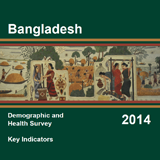
The 2014 Bangladesh Demographic and Health Survey (BDHS) is the seventh national-level demographic and health survey designed to provide information on demographic status, family planning, maternal health, and children’s health and nutritional status. The BDHS included a household survey of evermarried women age 15-49. The survey also included a community questionnaire administered during the listing of households to informants in communities around the sample points from which the households were selected. This report presents major findings from data collected in the household survey using the Household Questionnaire and the Woman’s Questionnaire. A more comprehensive and detailed report is scheduled for release later in 2015. The data in the final report are not expected to differ substantially from the findings presented in this key indicators report; however, the results presented here should be regarded as provisional and may be subject to modification. To examine trends, the findings from the 2014 survey have been compared with similar indicators from past surveys.
As in past BDHS surveys, the 2014 BDHS was conducted under the authority of the National Institute of Population Research and Training (NIPORT) of the Ministry of Health and Family Welfare (MOHFW). The survey was implemented by Mitra and Associates, a Bangladeshi research firm located in Dhaka. ICF International of Rockville, Maryland, USA, provided technical assistance to the project as part of its international Demographic and Health Surveys (DHS) Program. The survey received financial support from the U.S. Agency for International Development (USAID).
The main objective of the 2014 BDHS is to provide up-to-date information on fertility and childhood mortality levels; fertility preferences; awareness, approval, and use of family planning methods; maternal and child health, including breastfeeding practices, nutrition levels, and newborn care; knowledge and attitudes toward HIV/AIDS and other sexually transmitted infections (STIs); and community-level data on accessibility and availability of health and family planning services. This information is intended to assist policymakers and program managers in evaluating the Health, Population and Nutrition Sector Development Program (HPNSDP) 2011-16 and in designing programs and strategies for improving health and family planning services in the country.